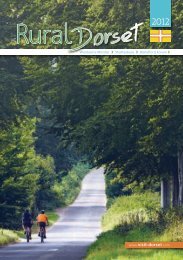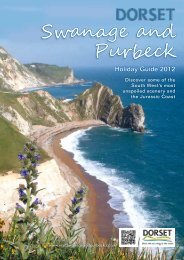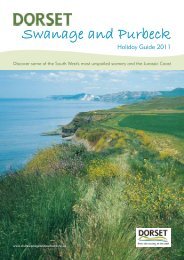Create successful ePaper yourself
Turn your PDF publications into a flip-book with our unique Google optimized e-Paper software.
The coastal scrub has a rich diversity of plant life;<br />
Wild privet, dogwood, hawthorn, wild madder, the<br />
parasitic ivy broomrape and nationally important<br />
but tiny, mosses, liverworts and lichens found on<br />
the rocks.<br />
If you have enjoyed this walk why not try one of<br />
the other circular walks at different places along<br />
the Legacy Trail. There are nine in total.<br />
The mosaic of scrub grassland and boulder scree in<br />
turn provides shelter and food for a wide range of<br />
resident and migratory birds and invertebrates.<br />
In places the invasive garden escapee cotoneaster<br />
is starting to cover the boulders and grassland and<br />
so management is on -going to remove this 'alien'.<br />
After meandering through the Weares, you'll<br />
arrive at the ground above the beach huts. One<br />
path hugs the top of the slope above the beach<br />
huts before joining the steps. There is a steepish<br />
slope down to the left of the path and so if you<br />
prefer, follow one of the paths up towards the<br />
wooded slope where you join the steps further up<br />
towards the view point. At the steps go down to<br />
Church Ope Cove or climb back up past Rufus<br />
Castle to the viewing point.<br />
It was worth climbing done the remaining steps to<br />
sit on the beach or go rock polling. Keep an eye out<br />
for bottlenose dolphins which can sometimes be<br />
seen from the Cove.<br />
Pop into the Portland Museum for more<br />
information and refreshments.<br />
The Legacy Trail and circular walks from key<br />
'waypoints' are part of the Wild About Weymouth<br />
and Portland Project funded by the Big Lottery<br />
Fund through Natural England's Access to<br />
Nature programme.<br />
It aims to improve access in and between wildlife<br />
sites and encourage local people and visitors to<br />
discover and explore the wonderful natural<br />
environment of Weymouth and Portland.<br />
For more information about the Legacy Trail and<br />
sites along the way visit:<br />
www.visit-dorset.com/about-the-area/countryside<br />
/weymouth-and-portland-legacy-trail<br />
Discover the Wild side<br />
<strong>LEGACY</strong> <strong>TRAIL</strong><br />
Circular walk<br />
<br />
The Weares and Church Ope Cove<br />
1.3 miles
Start<br />
This walk explores the unique landscape of the east<br />
coast, altered by landslips and quarrying but now<br />
being reclaimed and softened by nature. It is a very<br />
special area for wildlife particularly the smaller<br />
plants; mosses and lichens.<br />
Take a short walk from the museum, down to<br />
Church Ope Cove viewing area passing the 12th<br />
Century Rufus Castle on your right.<br />
Enjoy the views across the weares and the Cove<br />
below. In the early quarrying days, stone was shipped<br />
out on sailing barges from 3 piers around the Cove.<br />
Enormous loads of overburden were tipped over the<br />
cliffs into the sea between the Cove and Southwell.<br />
Length of walk: c1.3 miles<br />
Access: From the viewing point<br />
there are a few steps up to join the<br />
level railway line. The weares path is<br />
steep at the start, uneven and rocky.<br />
There are over 100 steps back up to<br />
the viewing area!<br />
Toilets and refreshments at the<br />
Portland Museum. Also there are<br />
toilets near the beach huts in the<br />
Cove. Free parking in the museum<br />
car park. Bus stop nearby.<br />
It probably contributed to the dramatic Southwell<br />
landslide in 1734 which affected this area even<br />
changing the composition of the Cove's beach. You<br />
can see boulders and rock layers at unusual angles<br />
because of the landslide.<br />
From the viewing point follow the Coast Path and<br />
Legacy Trail to the north along the disused<br />
passenger railway line.<br />
The line was opened in 1902 making its last journey in<br />
1965. You pass through a dramatic cutting, popular<br />
with climbers, where the railway swung round<br />
through the cliffs taking passengers towards Easton.<br />
In the cliffs you get fantastic views of the rock strata.<br />
The Lower Purbeck Beds, formed in shallow, lagoonal<br />
conditions, are at the top. Fossil trees and dinosaur<br />
footprints have also been found in this rock. Further<br />
down is the famous Portland limestone formed in<br />
Jurassic tropical seas, where giant ammonites swan,<br />
140 million years ago. Find out more about the fossils<br />
in the Portland museum.<br />
In places on the cliffs, you can see tufa or flow stone,<br />
formed in a similar way to the formation of stalactites<br />
in limestone caves. Impressive stone walls built to<br />
hold back the quarry waste abut the natural strata as<br />
you walk along the railway. Look out for ravens and<br />
peregrines and enjoy the views across to the Chalk<br />
cliffs at Lulworth, also part of the World Heritage Site.<br />
To the right are the Weares, a Celtic word meaning<br />
rough and wild land. These were previously common<br />
land for sheep grazing, before the quarrying and<br />
landslides.<br />
To explore Penn's Weares, take a winding, fairly<br />
steep path on the right, down to Durdle Pier which<br />
you can see from the railway line. Look out for the<br />
path just as the Grove Cliffs ahead come into view.<br />
Alternatively, you can carry on along the railway line<br />
until you reach the security fences of Portland Port,<br />
when you will have to turn back.<br />
The Grove Cliffs is a sanctuary area for breeding birds,<br />
such as fulmars. The old hand winch Derrick crane<br />
remains in place and rows of roughly shaped stone<br />
are lined up ready! Portland stone has been used to<br />
camouflage the WW2 lookouts. Durdle Pier is the<br />
only example of an 18th century quay to survive on<br />
the Island and was one of the main stone shipping<br />
places on the east side.<br />
From Durdle Pier take the meandering footpath<br />
between the boulders and scrub back towards<br />
Church Ope Cove.<br />
This landscape of landslips, toppled rocks and old<br />
quarrying is an extremely important area for wildlife.













